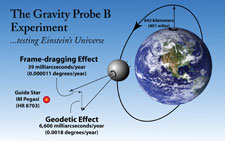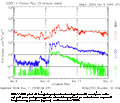WEEKLY HIGHLIGHTS FOR 12 NOVEMBER 2004:
GRAVITY PROBE B MISSION UPDATE

In its 30th week in orbit, the GP-B spacecraft is in good health and is performing well. We have completed 2.5 months of data collection, and the quality of the data continues to be excellent. The spacecraft is flying drag-free around gyro #3, while maintaining a constant roll rate of 0.7742 rpm (77.5 seconds per revolution). As we enter the second portion of the year when the spacecraft remains in full sunlight for approximately a month, the shell of the Dewar is warming up slightly, and thus rate of helium boiling off from the Dewar has increased slightly, resulting in a uniform increase of helium flow through the micro thrusters, in order to maintain the appropriate pressure inside the Dewar to keep its temperature stabilized at 1.82 kelvin.
On 7 November 2004, the National Oceanic & Atmospheric Administration’s (NOAA) Space Environment Center (SEC) issued the following advisory bulletin:

A large and moderately complex sunspot group, NOAA Region 696, was responsible for a series of eruptions on the surface of the Sun known as solar flares, including a significant eruption on 7 November 2004 at 9:06 a.m. MST. A radiation storm, currently at the moderate (S2) level, began soon after the eruption was observed on the Sun. Solar flare activity over the past few days has resulted in a series of Earth-directed coronal mass ejections (CMEs) that have impacted Earth's geomagnetic field with severe (G4) geomagnetic storming. Today's large eruption on the Sun may produce further periods of strong geomagnetic storming on 9-10 November.
Solar radiation storms, which result in increased proton bombardment of the Earth, coupled with the ensuing geomagnetic storm, has been responsible for an extraordinary display of the aurora borealis (northern lights) all over the Northern Hemisphere this past week. The aurora is typically only visible in places like Alaska and Canada, which are located at far northern latitudes. But this past week, people have reported seeing the aurora as far south as Alabama. In fact, NASA’s Astronomy Picture of the Day for 12 November 2004 is an extraordinary photo of the Aurora Borealis, taken by amateur astronomers in Warrensburg, Missouri on 7 November 2004.
The two plots to the right show a side-by-side comparison of normal solar activity from one month ago versus the activity during the geomagnetic storm this past Wednesday and Thursday. The difference is dramatic. Note especially the large increase in highest-level (green) proton flux on November 10th. The increase in these particles rarely rises above the 0.1 (first) level on this plot.
One of the effects of geomagnetic storming is a significant increase in high-energy proton bombardment in any part of the Earth facing the Sun, and especially in the region known as the South Atlantic Anomaly, which normally experiences heightened levels of solar particle bombardment.
 Thus, it was not surprising that at 4:58 PM PST on 10 November 2004, as the GP-B spacecraft was entering the South Atlantic Anomaly region, a proton hit a critical memory location in the SQUID Readout Electronics (SRE). This event triggered a chain reaction of safemodes that, among other things, halted the GP-B mission time line, caused the SRE computer to reboot, and transitioned all four gyros to analog backup suspension mode.
Thus, it was not surprising that at 4:58 PM PST on 10 November 2004, as the GP-B spacecraft was entering the South Atlantic Anomaly region, a proton hit a critical memory location in the SQUID Readout Electronics (SRE). This event triggered a chain reaction of safemodes that, among other things, halted the GP-B mission time line, caused the SRE computer to reboot, and transitioned all four gyros to analog backup suspension mode.
Over the past few weeks, the SRE electronics had sustained two proton hits to non-critical memory locations, and we were already in the process of planning the necessary steps to manually reboot it, but as it happens, nature apparently took care of this issue for us. Fortunately, the effects of this event were limited to the SRE electronics, and the spacecraft’s main (A-side) computer was not affected. Our team worked through the night this past Wednesday and most of Thursday, sending commands to the spacecraft to reset affected systems and restore all four gyros to digital suspension modes. As of this afternoon, the spacecraft has returned to normal operation. The effect of this event on the experimental data is not yet known. A few data points from this period may have to be omitted, but such an omission will have no significant effect on the overall experimental results.
For more information and photos of recent aurora activities, see the NASA feature story on the Aurora Borealis dated10 November 2004. For more information on solar activity and geomagnetic storms, see the NOAA/SEC Web site.
Drawings & photos: The diagram of the GP-B experiment and the map of the South Atlantic Anomaly are both from the GP-B Image Archives here at Stanford. The drawing of solar radiation bombarding the Earth was taken from the NOAA/SEC Web site Home page. The two plots of proton flux are from the NOA/SEC data archive. The photo, taken by Terry Lutz, of the Aurora Borealis over Ohio is from taken from a NASA feature story on the Aurora Borealis posted on 10 November 2004. Click on the thumbnails to view these images at full size.
Please Note: We will continue updating these highlights and sending out the GP-B email update on a weekly basis—at least through the first few weeks of the Science Phase of the mission. As mission operations become more routine, we may reduce the frequency of these updates to biweekly. However, from time to time, we intend to post special reports and special updates, as warranted by mission events.
SWISS AMATEUR ASTRONOMER PHOTOGRAPHS GP-B GP-B SPACECRAFT IN ORBIT WITH GUIDE STAR IM PEGASI
To the right, is a thumbnail of a photograph of the GP-B spacecraft in orbit, along with the guide star, IM Pegasi. (Click on the thumbnail to view the photo at full size.) The photo was taken and emailed to us by Stefano Sposetti, a Swiss physics teacher and amateur astronomer. Stefano used a 40cm newtonian telescope, with a CCD camera and 20mm wide field lens attached to make this photo. He then sent us the two versions shown — the normal (black sky) version on the right, and an inverse version in which the constellation, Pegasus, the guide star IM Pegasi, and the path of the GP-B spacecraft are highlighted for easy identification on the left.

We are grateful to Stefano for sending us this wonderful photo. You can view other astronomical photos that he has taken on his Web page: http://aida.astronomie.info/sposetti. Following is Stefano's description of his photo:
In this picture one can see the quite dim GP-B satellite traveling from North (up) to South (down) direction. The bold line in the right part of the left image represents the satellite trail just before entering the earth shadow. (Every satellite becomes visible because it reflects the sunlight). The connecting lines show the constellation Pegasus. The small circle around the star is IM Pegasi, the guide star used by the spacecraft's telescope in his experiment! GP-B is a circumpolar satellite following a free fall trajectory about 640km above the earth surface. From my location the satellite passed that night at a maximum elevation of 87degrees, thus not exactly overhead. The brightness of the satellite was between 3mag and 4mag. The Moon, about in the last quarter phase, illuminated the sky and was a drawback for having a good signal/noise ratio of the satellite trace. I took this 60-seconds black and white CCD picture with a 20mm,f/2.8 lens on august 6 centered at 01:19:00 UT. North is up, East is left.
More links on recent topics
- Track the satellite in the sky
- Photo, video & and news links
- Build a paper model of the GP-B Spacecraft
- Following the mission online
- Our mailing list - receive the weekly highlights via email
- The GP-B Launch Companion in Adobe Acrobat PDF format. Please note: this file is 1.6 MB, so it may take awhile to download if you have a slow Internet connection.
Previous Highlight
Index of Highlights



